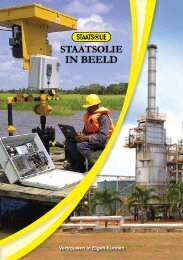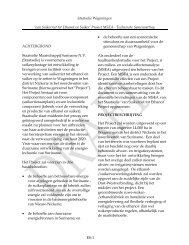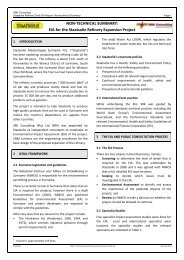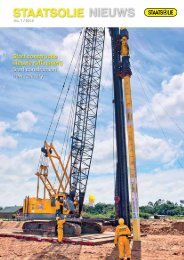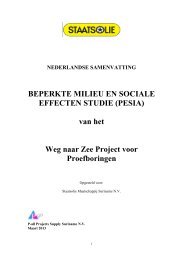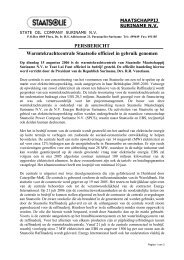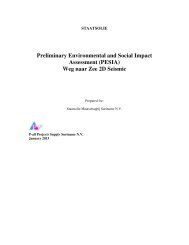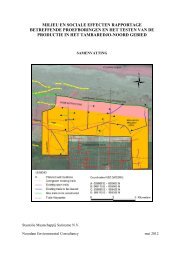6 Staatsolie Nieuws
6 Staatsolie Nieuws
6 Staatsolie Nieuws
Create successful ePaper yourself
Turn your PDF publications into a flip-book with our unique Google optimized e-Paper software.
OLIEWEETJES OIL & GAS NEWS<br />
<br />
<br />
<br />
<br />
<br />
<br />
<br />
<br />
<br />
<br />
<br />
<br />
<br />
<br />
<br />
<br />
<br />
<br />
<br />
<br />
<br />
<br />
<br />
<br />
<br />
<br />
<br />
<br />
<br />
<br />
<br />
<br />
<br />
<br />
<br />
<br />
<br />
<br />
<br />
<br />
<br />
<br />
<br />
<br />
<br />
<br />
<br />
<br />
<br />
<br />
<br />
<br />
<br />
<br />
Brazilian Government to Reduce Ethanol Content of Gasoline<br />
Brazilian Mines and Energy Minister Edison Lobao stated that the<br />
government will reduce the admixture of alcohol with gasoline provided<br />
to service stations from 25 to 20 beginning 1 October.<br />
Brazil uses sugarcane to produce ethanol as an additive to gasoline.<br />
While Brazil is currently the world’s leading exporter of ethanol, the<br />
U.S. Energy Information Administration recently wrote in its weekly<br />
petroleum report, “For the remainder of 2011, it is likely that the United<br />
States will surpass Brazil as the world’s largest ethanol exporter due to<br />
recent supply shortages and resulting high sugar prices in Brazil.”<br />
High sugar prices are making U.S. corn-based ethanol more<br />
competitive and allowing U.S. ethanol producers to enter markets that<br />
previously exclusively imported Brazilian ethanol. The government’s<br />
decision is the result of a disappointing cane crop and the incentive of<br />
higher global prices to turn more of the harvested sugarcane into sugar<br />
rather than fuel.<br />
Lobao said, “We realized that next year’s harvest will not be much<br />
better than the current one. So we need to act early, considering both<br />
the present and the future on a precautionary basis.”<br />
Further complicating the picture, indigenous Brazilian demand for<br />
ethanol has outpaced production as its growing middle class buys<br />
more flex fuel cars. Source: www.downstreamtoday.com<br />
Shell Oilfield Find off French Guiana<br />
Shell Oil Company and British Tullow Oil have discovered an oilfield<br />
off the coast of French Guiana, both companies reported on Friday<br />
September 9. Shell executive vice-president Dave Lawrence of Shell’s<br />
Exploration division says it is yet too early to determine the extent of<br />
the find, but the preliminary data looks promising.<br />
Shell has a 45 percent stake in the so-called Guiana Maritime Permit,<br />
an area covering some 32,000 sq kilometers. The sea in the permit<br />
area has depths ranging from two to three kilometers. Shell shares<br />
the area off French Guiana with Tullow Oil (27.5%), Total (25%) and<br />
Northpet Investments, which has a 2.5% stake. Source: ww.fd.nl<br />
Petrobras Starts Production at Platform P-56<br />
Petrobras announced that semisubmersible platform P-56 began<br />
production on August 15, at Marlim Sul field, in Campos Basin (RJ).<br />
The unit began production through well 7-MLS-163HPRJS, which has<br />
a potential of approximately 16,000 barrels per day.<br />
Installed at a water depth of 1,670 meters, the platform is designed<br />
to process up to 100 thousand barrels of oil per day when it reaches<br />
maximum capacity, expected to take place in the first quarter of 2012.<br />
Besides heavy oil of 18º API, P-56 will have the capacity to process<br />
and treat up to 6 million m³ per day of natural gas.<br />
P-56 will be interconnected to 21 wells, of which 10 will be producers<br />
and 11 water injectors. The produced oil will be sent through oil pipeline<br />
to platform P-38, which is a FSO (floating storage and offloading<br />
vessel) type, located 20 km from the Platform. Then, the oil will be<br />
transferred to shuttle tankers and the natural gas will be delivered<br />
through gas pipeline to the Cabiúnas terminal.<br />
P-56 is 125m long, 110m wide, 137m tall and has a total weight of<br />
more than 54 thousand tons. Construction of the integrated modules<br />
(topside) of P-56 reached a high rate of local content. The hull was<br />
built entirely in Brazil, which demonstrates the capacity of the local<br />
manufacturing sector to meet the orders of Petrobras.<br />
27<br />
Source: www.rigzone.com<br />
<strong>Staatsolie</strong> <strong>Nieuws</strong> • No. 2 • 2011





